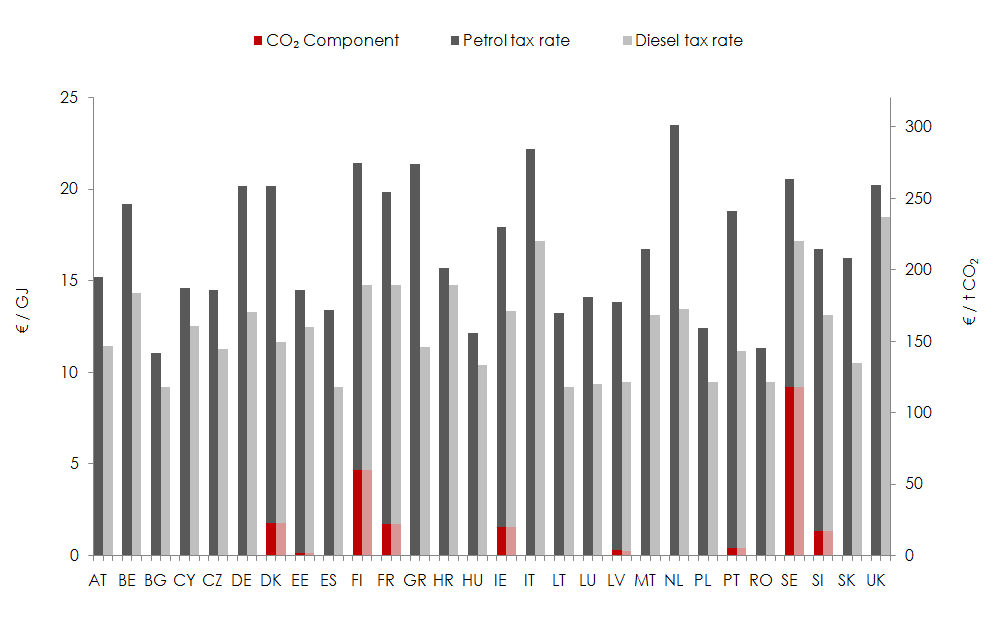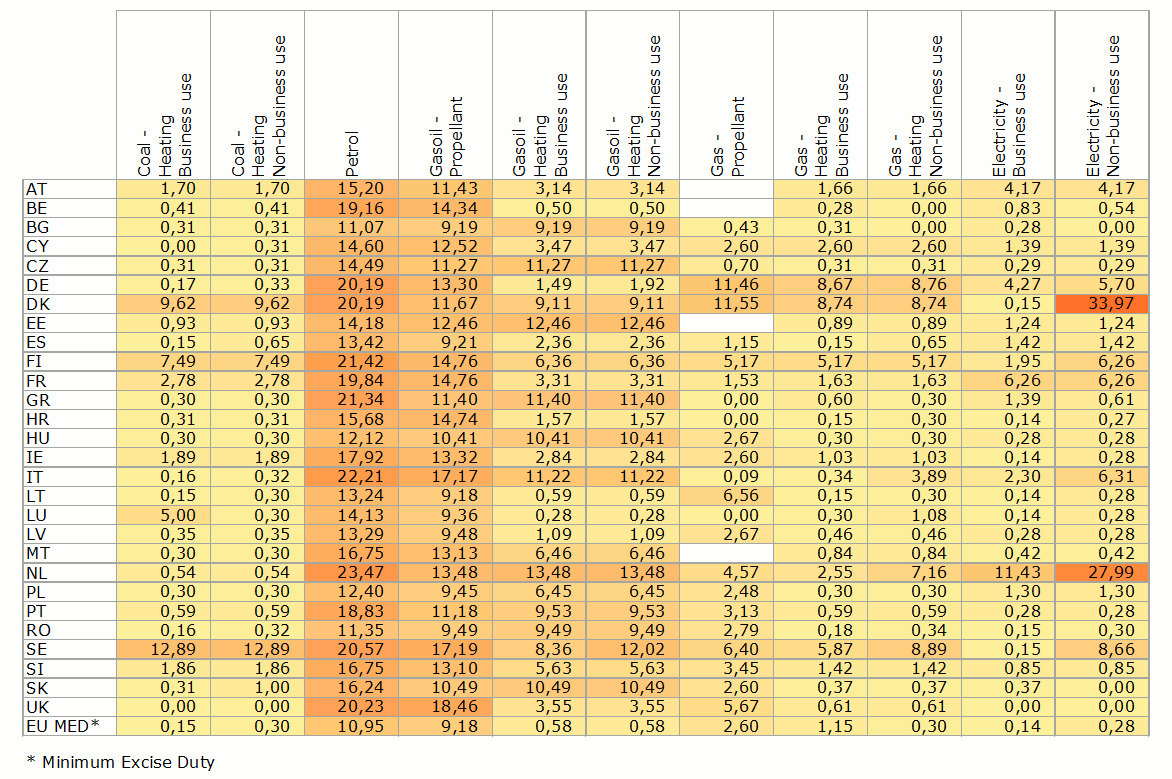Work Package 2: Quantitative Assessment of Carbon Taxes in the EU
Description
In the EU, CO2 emissions from industry and energy supply are regulated under the EU ETS. To control emissions from private households, transport and other small sources, in contrast, no comprehensive EU policy strategy is in place. In 2011, the European Commission came up with a proposal for a new energy taxation directive that would put more emphasis on the carbon content of fuels. This proposal has, however, not been adopted due to resistance of some Member States and the requirement of unanimity for EU tax law. Although some climate change aspects have been taken up in the Member States' energy taxation following the EU's energy taxation directive in 2003, the existing energy or carbon taxes serve mainly a revenue-raising purpose and only in some cases an explicit reduction of emissions is intended. Energy tax rates still differ widely between Member States and energy sources, also regarding fuels consumed in the transport sector (see Figure).
In this work package, a cross-country comparison of energy taxes has been performed. Energy tax rates by fuel and application area were reviewed based on the European Commission's taxation reports. In addition, for the countries that have introduced carbon taxes the carbon component of the taxes was assessed and implicit carbon tax rates were calculated for all Member States for the years 1995 and 2000-2017, provided availability of the data. The development of the taxes was analysed, i.a. in terms of the tax rates applied (and their development over time) and tax revenues. While the main focus of the CATs project lay on consumption-based carbon taxes, non-recurrent taxes (e.g. vehicle registration taxes) and recurrent taxes on capital stocks (e.g. engine-related insurance taxes) were also discussed.
Moreover, the outcomes of the introduction of the tax were investigated: The development of CO2 emissions in the transport sector were analysed using data from the Odyssee 2017 database. Moreover, a meta-analysis of studies available for the selected 'front runner' countries was conducted in order to assess the effectiveness of the taxes in more detail, as well as the observed impacts on economic growth and employment, but also the related distributional effects.
Results and Conclusions
The Energy Taxation Directive (Directive 2003/96/EC) provides minimum tax rates for propellants, heating fuels and electricity in the EU Member States. While effective excise duties correspond to the minima in some Member States, in others the tax rates are considerably higher. As also provided for in Directive 2003/96/EC, the highest taxes are levied on fuels used as propellant, i.e. on petrol and diesel, as well as on gas. Minimum tax rates for heating fuels amount to 1-11% of the minimum tax rate for petrol and are highest for gasoil. Converting the (minimum) energy tax rates based on the fuels' carbon content into a CO2 price signal delivers the implicit carbon tax rates levied in the EU Member States as of January 2017. With respect to propellants, implicit carbon minimum tax rates are 128 /t CO2 for diesel and 140 /CO2 for petrol. For coal used as heating fuel, in contrast, minimum tax rates are 1.6 /t CO2 for business use and 3.2 /t CO2 for non-business use respectively. This spread of excise duties is in stark contrast to the economic theory on carbon pricing, postulating uniform taxation of emissions as a prerequisite for efficient regulation. Explicit CO2 taxes so far have been introduced in about one third of the Member States. In most of these countries the CO2 tax covers, however, only a small part of the overall tax rate on energy and is well below 10 /t CO2. Notable exceptions in this regard are Sweden where the carbon component has increased to 118 /t CO2 and Finland with a CO2 component of about 60 /t CO2 in 2017.
Petrol and diesel tax rates in the EU-28 (2017)

Source: EU Excise Duty Tables, January 2017, own calculations
With respect to the transport sector, upfront taxes such as registration taxes can be a useful complement to fuel-based taxes by counterbalancing consumer myopia regarding purchase decisions: Instead of considering the purchase price and the expected usage costs over the whole lifetime of the vehicle, consumers tend to consider only the first years of usage for their decision. In 2016, 14 EU Member States incorporated the CO2 emissions of a vehicle for determining registration taxes and recurring ownership taxes. In four of these countries (Cyprus, Estonia, France and Latvia), specific CO2 emissions are the only criterion for acquisition taxes; in the other countries CO2 emissions are combined with other factors (such as purchase prices or cylinder capacity). Overall cars CO2 intensities tend to be lower in Member States with higher ownership and especially purchase taxes but high vehicle tax levels alone do not guarantee for a shift towards low-emission vehicles.
Research on energy price elasticities suggests that energy and carbon taxation can make a significant contribution towards achieving emission reductions, particularly in the transport sector where greenhouse gas emissions continue to be on the rise in the EU. Evidence on the economic impacts of energy and carbon taxes furthermore shows that a double divided can be achieved. With respect to the distributional impacts of carbon and energy taxes evidence is, however, mixed. While empirical studies generally negate regressive effects for taxes on transport fuels, energy and carbon taxes on heating fuels tend to be found regressive.
The CATs working paper on the empirical evidence on energy and carbon taxation in EU Member States is available for download here:
Results of Work Packages 2 have also been published in a book chapter:
- Kettner C. and D. Kletzan-Slamanig (2017), Carbon taxation in EU Member States: evidence from the transport sector, in: Weishaar S.E. et al. (eds.), The Green Market Transition Carbon Taxes, Energy Subsidies and Smart Instrument Mixes, Critical Issues in Environmental Taxation Vol. 19, Edward Elgar, 1729.
Supplementary material
- Table: Energy tax rates in the EU-28 (2017)
- Table: Implicit CO2 tax rates in the EU-28 (2017)
- Table: Energy tax rates in the EU-28 (2016)
- Table: Implicit CO2 tax rates in the EU-28 (2016)
Energy tax rates in the EU-28 (2017)

Source: EU Excise Duty Tables, January 2017, own calculations


